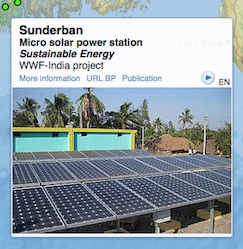WWF-India helps far flung villages access grid quality power.
 Access to safe, clean energy is fundamental to poverty eradication, to stopping deforestation, and to stopping climate change. Most poor people and inhabitants of remote locations meet the majority of their energy needs by collecting biomass (fuel wood, agricultural waste and dung). Many also have to use other expensive resources like kerosene.
Access to safe, clean energy is fundamental to poverty eradication, to stopping deforestation, and to stopping climate change. Most poor people and inhabitants of remote locations meet the majority of their energy needs by collecting biomass (fuel wood, agricultural waste and dung). Many also have to use other expensive resources like kerosene.
Use of biomass and kerosene has bearing on biodiversity and deforestation (through the impacts of collecting firewood and human-wildlife conflict), and equally to climate change since black carbon (soot) and kerosene are significant contributors to global warming. Access to clean energy therefore, has clear connections between human wellbeing and environment protection.
In India today, many thousands of villages are without access to safe and clean energy. These villages are often too remote for grid electricity to be considered a technically or economically feasible option. For these villages to be electrified, the only solution is a standalone (distributed generation) power system.
Lighting Sundarbans’ homes
On 9 March 2011, WWF-India and CAT Projects Australia inaugurated a micro solar power station at Rajat Jubilee on Satjelia Island in the Sundarbans region of West Bengal using the Bushlight India Model. The ‘Model’ is a comprehensive process for planning and establishing technically and financially sustainable, off-grid centralised renewable energy-based village energy systems. It is based on the highly successful ‘Bushlight’ project which, since 2002, has been providing remote indigenous communities in Australia with access to reliable renewable energy services. It is a scalable solution that can provide access to safe and clean energy in the form of grid quality electricity in remote areas. The micro solar power station at Rajat Jubilee connects 50 households, six local businesses and three community buildings and supplies uninterrupted grid quality power.
The ‘Bushlight’ model involves a comprehensive community engagement and energy planning framework. At Rajat Jubilee, local residents underwent energy efficiency education and training which enabled them to draw up energy budgets for 24 hour cycles. The energy budgets then led to system design allowing provisioning of a predetermined, assured amount of daily energy to all consumers and providing the community with the information and tools to use this energy to complement and build their livelihoods as they need and choose on a day to day basis. This is made possible through the installation of unique demand side management hardware (programmable energy meter) called Urja Bandhu. It is hoped that the energy planning framework and programmable energy meter will prove to be of relevance to the remote village electrification work going on in the country and contribute simultaneously to human wellbeing and environment protection.
Read More: WWF-India















